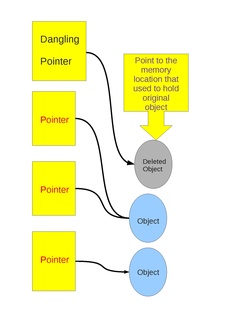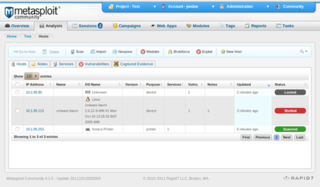 W
WAn exploit is a piece of software, a chunk of data, or a sequence of commands that takes advantage of a bug or vulnerability to cause unintended or unanticipated behavior to occur on computer software, hardware, or something electronic. Such behavior frequently includes things like gaining control of a computer system, allowing privilege escalation, or a denial-of-service attack.
 W
WIn computer security, a vulnerability is a weakness which can be exploited by a threat actor, such as an attacker, to cross privilege boundaries within a computer system. To exploit a vulnerability, an attacker must have at least one applicable tool or technique that can connect to a system weakness. In this frame, vulnerabilities are also known as the attack surface.
 W
WArmitage is a graphical cyber attack management tool for the Metasploit Project that visualizes targets and recommends exploits. It is a free and open source network security tool notable for its contributions to red team collaboration allowing for: shared sessions, data, and communication through a single Metasploit instance. Armitage is written and supported by Raphael Mudge.
 W
WBlueKeep is a security vulnerability that was discovered in Microsoft's Remote Desktop Protocol (RDP) implementation, which allows for the possibility of remote code execution.
 W
WDangling pointers and wild pointers in computer programming are pointers that do not point to a valid object of the appropriate type. These are special cases of memory safety violations. More generally, dangling references and wild references are references that do not resolve to a valid destination, and include such phenomena as link rot on the internet.
 W
WThe DROWN attack is a cross-protocol security bug that attacks servers supporting modern SSLv3/TLS protocol suites by using their support for the obsolete, insecure, SSL v2 protocol to leverage an attack on connections using up-to-date protocols that would otherwise be secure. DROWN can affect all types of servers that offer services encrypted with SSLv3/TLS yet still support SSLv2, provided they share the same public key credentials between the two protocols. Additionally, if the same public key certificate is used on a different server that supports SSLv2, the TLS server is also vulnerable due to the SSLv2 server leaking key information that can be used against the TLS server.
 W
WEfail, also written EFAIL, is a security hole in email systems with which content can be transmitted in encrypted form. This gap allows attackers to access the decrypted content of an email if it contains active content like HTML or JavaScript, or if loading of external content has been enabled in the client. Affected email clients include Gmail, Apple Mail, and Microsoft Outlook.
 W
WTor, short for The Onion Router, is free and open-source software for enabling anonymous communication. It directs Internet traffic through a free, worldwide, volunteer overlay network, consisting of more than six thousand relays, for concealing a user's location and usage from anyone conducting network surveillance or traffic analysis. Using Tor makes it more difficult to trace the Internet activity to the user. Tor's intended use is to protect the personal privacy of its users, as well as their freedom and ability to conduct confidential communication by keeping their Internet activities unmonitored.
 W
WAn evil maid attack is an attack on an unattended device, in which an attacker with physical access alters it in some undetectable way so that they can later access the device, or the data on it.
 W
WForeshadow, known as L1 Terminal Fault (L1TF) by Intel, is a vulnerability that affects modern microprocessors that was first discovered by two independent teams of researchers in January 2018, but was first disclosed to the public on 14 August 2018. The vulnerability is a speculative execution attack on Intel processors that may result in the disclosure of sensitive information stored in personal computers and third-party clouds. There are two versions: the first version (original/Foreshadow) targets data from SGX enclaves; and the second version (next-generation/Foreshadow-NG) targets virtual machines (VMs), hypervisors (VMM), operating systems (OS) kernel memory, and System Management Mode (SMM) memory. A listing of affected Intel hardware has been posted.
 W
WHeartbleed was a security bug in the OpenSSL cryptography library, which is a widely used implementation of the Transport Layer Security (TLS) protocol. It was introduced into the software in 2012 and publicly disclosed in April 2014. Heartbleed could be exploited regardless of whether the vulnerable OpenSSL instance is running as a TLS server or client. It resulted from improper input validation in the implementation of the TLS heartbeat extension. Thus, the bug's name derived from heartbeat. The vulnerability was classified as a buffer over-read, a situation where more data can be read than should be allowed.
 W
WThe idle scan is a TCP port scan method that consists of sending spoofed packets to a computer to find out what services are available. This is accomplished by impersonating another computer whose network traffic is very slow or nonexistent. This could be an idle computer, called a "zombie".
 W
WIn computer programming, an integer overflow occurs when an arithmetic operation attempts to create a numeric value that is outside of the range that can be represented with a given number of digits – either higher than the maximum or lower than the minimum representable value.
 W
WKRACK is a replay attack on the Wi-Fi Protected Access protocol that secures Wi-Fi connections. It was discovered in 2016 by the Belgian researchers Mathy Vanhoef and Frank Piessens of the University of Leuven. Vanhoef's research group published details of the attack in October 2017. By repeatedly resetting the nonce transmitted in the third step of the WPA2 handshake, an attacker can gradually match encrypted packets seen before and learn the full keychain used to encrypt the traffic.
 W
WLoad value injection (LVI) is an attack on Intel microprocessors that can be used to attack Intel's Software Guard Extensions (SGX) technology. It is a development of the previously known Meltdown security vulnerability. Unlike Meltdown, which can only read hidden data, LVI can inject data values, and is resistant to the countermeasures so far used to mitigate the Meltdown vulnerability.
 W
WMalware is any software intentionally designed to cause damage to a computer, server, client, or computer network. By contrast, software that causes unintentional harm due to some deficiency is typically described as a software bug. A wide variety of malware types exist, including computer viruses, worms, Trojan horses, ransomware, spyware, adware, rogue software, wiper and scareware.
 W
WMeltdown is a hardware vulnerability affecting Intel x86 microprocessors, IBM POWER processors, and some ARM-based microprocessors. It allows a rogue process to read all memory, even when it is not authorized to do so.
 W
WThe Metasploit Project is a computer security project that provides information about security vulnerabilities and aids in penetration testing and IDS signature development. It is owned by Boston, Massachusetts-based security company Rapid7.
 W
WThe Microarchitectural Data Sampling (MDS) vulnerabilities are a set of weaknesses in Intel x86 microprocessors that use hyper-threading, and leak data across protection boundaries that are architecturally supposed to be secure. The attacks exploiting the vulnerabilities have been labeled Fallout, RIDL, ZombieLoad., and ZombieLoad 2.
 W
WIn computing and telecommunications, the payload is the part of transmitted data that is the actual intended message. Headers and metadata are sent only to enable payload delivery.
 W
WPrivilege escalation is the act of exploiting a bug, design flaw or configuration oversight in an operating system, or software application to gain elevated access to resources that are normally protected from an application or user. The result is that an application with more privileges than intended by the application developer or system administrator can perform unauthorized actions.
 W
WA race condition or race hazard is the condition of an electronics, software, or other system where the system's substantive behavior is dependent on the sequence or timing of other uncontrollable events. It becomes a bug when one or more of the possible behaviors is undesirable.
 W
WReflected DOM Injection (RDI) is an evasive XSS technique which uses a third party website to construct and execute an attack. This technique can be implemented on websites that use a user-provided URL as part of their service
 W
WRyuk is a type of ransomware known for targeting large, public-entity Microsoft Windows cybersystems. It typically encrypts data on an infected system, rendering the data inaccessible until a ransom is paid in untraceable bitcoin. Ryuk is believed to be used by two or more criminal groups, most likely Russian, who target organizations rather than individual consumers.
 W
WA smudge attack is an information extraction attack that discerns the password input of a touchscreen device such as a cell phone or tablet computer from fingerprint smudges. A team of researchers at the University of Pennsylvania were the first to investigate this type of attack in 2010. An attack occurs when an unauthorized user is in possession or is nearby the device of interest. The attacker relies on detecting the oily smudges produced and left behind by the user's fingers to find the pattern or code needed to access the device and its contents. Simple cameras, lights, fingerprint powder, and image processing software can be used to capture the fingerprint deposits created when the user unlocks their device. Under proper lighting and camera settings, the finger smudges can be easily detected, and the heaviest smudges can be used to infer the most frequent input swipes or taps from the user.
 W
WSpectre is a vulnerability that affects modern microprocessors that perform branch prediction. On most processors, the speculative execution resulting from a branch misprediction may leave observable side effects that may reveal private data to attackers. For example, if the pattern of memory accesses performed by such speculative execution depends on private data, the resulting state of the data cache constitutes a side channel through which an attacker may be able to extract information about the private data using a timing attack.
 W
WSQL injection is a code injection technique used to attack data-driven applications, in which malicious SQL statements are inserted into an entry field for execution. SQL injection must exploit a security vulnerability in an application's software, for example, when user input is either incorrectly filtered for string literal escape characters embedded in SQL statements or user input is not strongly typed and unexpectedly executed. SQL injection is mostly known as an attack vector for websites but can be used to attack any type of SQL database.
 W
WStagefright is the name given to a group of software bugs that affect versions 2.2 "Froyo" of the Android operating system. The name is taken from the affected library, which among other things, is used to unpack MMS messages. Exploitation of the bug allows an attacker to perform arbitrary operations on the victim's device through remote code execution and privilege escalation. Security researchers demonstrate the bugs with a proof of concept that sends specially crafted MMS messages to the victim device and in most cases requires no end-user actions upon message reception to succeed—the user doesn't have to do anything to 'accept' exploits using the bug; it happens in the background. A phone number is the only information needed to carry out the attack.
 W
WSwatting is a criminal harassment tactic of deceiving an emergency service into sending a police and emergency service response team to another person's address. This is triggered by false reporting of a serious law enforcement emergency, such as a bomb threat, murder, hostage situation, or a false report of a "mental health" emergency, such as reporting that a person is allegedly suicidal or homicidal and may or may not be armed.
 W
WThis timeline of computer viruses and worms presents a chronological timeline of noteworthy computer viruses, computer worms, Trojan horses, similar malware, related research and events.
 W
WVault 7 is a series of documents that WikiLeaks began to publish on 7 March 2017, detailing the activities and capabilities of the United States Central Intelligence Agency to perform electronic surveillance and cyber warfare. The files, dating from 2013 to 2016, include details on the agency's software capabilities, such as the ability to compromise cars, smart TVs, web browsers, and the operating systems of most smartphones, as well as other operating systems such as Microsoft Windows, macOS, and Linux. A CIA internal audit identified 91 malware tools out of more than 500 tools in use in 2016 being compromised by the release.
 W
WA computer virus is a type of computer program that, when executed, replicates itself by modifying other computer programs and inserting its own code. If this replication succeeds, the affected areas are then said to be "infected" with a computer virus, a metaphor derived from biological viruses.
 W
WA vulnerability scanner is a computer program designed to assess computers, networks or applications for known weaknesses. These scanners are used to discover the weaknesses of a given system. They are utilized in the identification and detection of vulnerabilities arising from mis-configurations or flawed programming within a network-based asset such as a firewall, router, web server, application server, etc. Modern vulnerability scanners allow for both authenticated and unauthenticated scans. Modern scanners are typically available as SaaS ; provided over the internet and delivered as a web application. The modern vulnerability scanner often has the ability to customize vulnerability reports as well as the installed software, open ports, certificates and other host information that can be queried as part of its workflow.Authenticated scans allow for the scanner to directly access network based assets using remote administrative protocols such as secure shell (SSH) or remote desktop protocol (RDP) and authenticate using provided system credentials. This allows the vulnerability scanner to access low-level data, such as specific services and configuration details of the host operating system. It's then able to provide detailed and accurate information about the operating system and installed software, including configuration issues and missing security patches. Unauthenticated scans is a method that can result in a high number of false positives and is unable to provide detailed information about the assets operating system and installed software. This method is typically used by threat actors or security analyst trying determine the security posture of externally accessible assets.
 W
WThe WannaCry ransomware attack was a worldwide cyberattack in May 2017 by the WannaCry ransomware cryptoworm, which targeted computers running the Microsoft Windows operating system by encrypting data and demanding ransom payments in the Bitcoin cryptocurrency. It propagated through EternalBlue, an exploit developed by the United States National Security Agency (NSA) for older Windows systems. EternalBlue was stolen and leaked by a group called The Shadow Brokers at least a year prior to the attack. While Microsoft had released patches previously to close the exploit, much of WannaCry's spread was from organizations that had not applied these, or were using older Windows systems that were past their end-of-life. These patches were imperative to an organization's cyber-security but many were not applied because of neglect, ignorance, mismanagement, or a misunderstanding about their importance. Some have claimed a need for 24/7 operation, aversion to risking having formerly working applications breaking because of patch changes, lack of personnel or time to install them, or other reasons.
 W
WWarchalking is the drawing of symbols in public places to advertise an open Wi-Fi network. Inspired by hobo symbols, the warchalking marks were conceived by a group of friends in June 2002 and publicised by Matt Jones who designed the set of icons and produced a downloadable document containing them. Within days of Jones publishing a blog entry about warchalking, articles appeared in dozens of publications and stories appeared on several major television news programs around the world.
 W
WWardriving is the act of searching for Wi-Fi wireless networks, usually from a moving vehicle, using a laptop or smartphone. Software for wardriving is freely available on the internet.